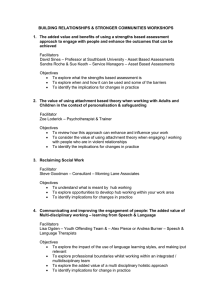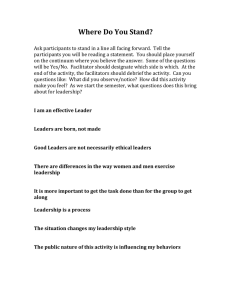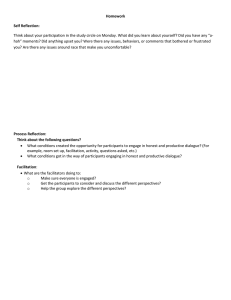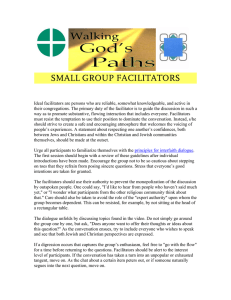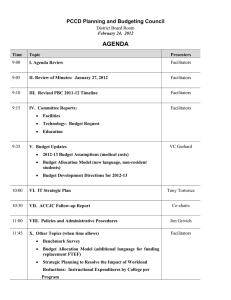(4) How to Develop and Produce Simple Learning Materials with
advertisement
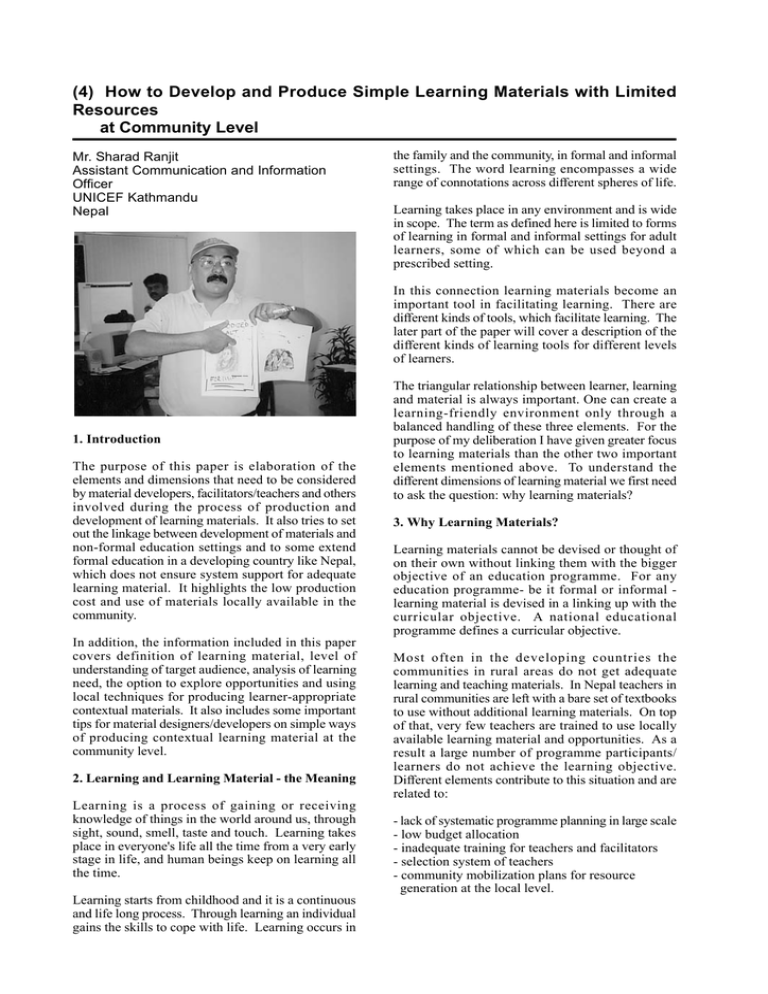
(4) How to Develop and Produce Simple Learning Materials with Limited Resources at Community Level Mr. Sharad Ranjit Assistant Communication and Information Officer UNICEF Kathmandu Nepal the family and the community, in formal and informal settings. The word learning encompasses a wide range of connotations across different spheres of life. Learning takes place in any environment and is wide in scope. The term as defined here is limited to forms of learning in formal and informal settings for adult learners, some of which can be used beyond a prescribed setting. In this connection learning materials become an important tool in facilitating learning. There are different kinds of tools, which facilitate learning. The later part of the paper will cover a description of the different kinds of learning tools for different levels of learners. 1. Introduction The purpose of this paper is elaboration of the elements and dimensions that need to be considered by material developers, facilitators/teachers and others involved during the process of production and development of learning materials. It also tries to set out the linkage between development of materials and non-formal education settings and to some extend formal education in a developing country like Nepal, which does not ensure system support for adequate learning material. It highlights the low production cost and use of materials locally available in the community. In addition, the information included in this paper covers definition of learning material, level of understanding of target audience, analysis of learning need, the option to explore opportunities and using local techniques for producing learner-appropriate contextual materials. It also includes some important tips for material designers/developers on simple ways of producing contextual learning material at the community level. 2. Learning and Learning Material - the Meaning Learning is a process of gaining or receiving knowledge of things in the world around us, through sight, sound, smell, taste and touch. Learning takes place in everyone's life all the time from a very early stage in life, and human beings keep on learning all the time. Learning starts from childhood and it is a continuous and life long process. Through learning an individual gains the skills to cope with life. Learning occurs in The triangular relationship between learner, learning and material is always important. One can create a learning-friendly environment only through a balanced handling of these three elements. For the purpose of my deliberation I have given greater focus to learning materials than the other two important elements mentioned above. To understand the different dimensions of learning material we first need to ask the question: why learning materials? 3. Why Learning Materials? Learning materials cannot be devised or thought of on their own without linking them with the bigger objective of an education programme. For any education programme- be it formal or informal learning material is devised in a linking up with the curricular objective. A national educational programme defines a curricular objective. Most often in the developing countries the communities in rural areas do not get adequate learning and teaching materials. In Nepal teachers in rural communities are left with a bare set of textbooks to use without additional learning materials. On top of that, very few teachers are trained to use locally available learning material and opportunities. As a result a large number of programme participants/ learners do not achieve the learning objective. Different elements contribute to this situation and are related to: - lack of systematic programme planning in large scale - low budget allocation - inadequate training for teachers and facilitators - selection system of teachers - community mobilization plans for resource generation at the local level. c. I have mentioned all this as teaching and learning material cannot be devised in isolation without linking up with some educational objective under an educational programme. While the hierarchy of programme objectives may change or differ at the community and national levels, the objective of learning should link up with the ultimate goal when evaluating the impact at the end of an intervention. Monitoring/Evaluation 6. Steps to Develop Learning Material (1) Identification of problem and need (2) Analysis of the problem a. Resistance pattern/KAP Teachers and facilitators are left in isolation with the task of making a difference in the lives of women and children. The choice is in the hands of teachers or facilitators to make the difference. The content of this paper elaborates some ways at the disposal of teachers and facilitators. (3) Analysis of the problem a. Identification of need and motivating factors b. Persuasion tactics (4) Objective setting Facilitators are not there by choice or aptitude but by default, due to lack of opportunity. A teacher who has freely chosen his calling does not get adequate training and is left alone in the community to teach there. (5) Selection of the topics (6) Format selection (7) Content arrangement a. Script visual (8) Editing (9) Testing (10) Revision 4. Rationale for Locally Produced Material Most often developing countries have difficulty in delivering adequate learning material for the education outlet. And because of this learning objectives are often not met. As a result there is poor realization of educational goal, and objectives go largely unmet. There are different factors behind this. These include low budget allocation for production and distribution, poor monitoring mechanism, and weak political commitment. It is a compounded problem. Even if there is intention the limitations are also there. 5. Factors behind Ineffective Learning Materials (1) Material centrally produced is not need based a. Centrally through out perspectives are imposed b. Degeneration of interest (2) Irrelevance to the context of local environments a. Dress b. Work in every day life (3) Vocabulary a. National language b. Multi-lingual situation (4) No cultural sensitivity a. Do not reflect day-to-day way of life b. Community values (5) Inadequate supply a. Expensive for the government (6) No system support a. Distribution b. Capacity building 7. Ways to Develop Simple Learning Materials Against this background on meaning, rationale and clarity of learning material the topic elaborates on a few tips for using different forms of possible communication format to facilitate learning in the communities. If a facilitator/material developer does not have the skills to develop learning material, there is always the possibility of using talent of different caliber available in the teaching and learning environment. In most communities there is always some natural talent in expressing feelings through song, the spoken word or symbolic visual forms. A good facilitator can always use such talent as a resource for devising learning material that suits the community. The topics in this chapter suggest a few tips for use in audio-visual format and the print medium. “Health worker educating a community” written by Mr. Ranjit 8. Visual Formats (1) Use of clip-art picture/illustration Clip art: A collection of illustrations which cover common topics such as health education, nutrition, environment education and other issues relating to the development of education. The clip can be imported in a computer to produce a computer graphic as per the requirements of the material as desired. In the absence of computers there are several ways of using and copying illustrations in clip art by tracing, copying and adapting to the needs of a local situation. Tracing Copying using charcoal Enlarging (2) Stick pictures Stick pictures are simple to illustrate. You do not need to be an artist to be able to draw in this style. The point is just to convey the message. A facilitator, with a bit of practice, can find this picture form handy. (3) Opportunities using magazines Printed material could be a great resource for developing learning materials. There are always some kinds of printed materials like newspapers and magazines available in the community. With a bit of mobilization of learners or participants, there is always the possibility of collection old magazines with pictures that can be used for creating learning material. The magazines can be used for creating collages, reference drawings and tracing. It is up to the facilitator or material developer. (4) Use of local talent As said earlier there is always talent among the participants or in a classroom situation. We will find different skills in writing and visualizing. It is only a matter of identifying them. As for the quality output, the illustration and their content do not have to sound at the beginning. The other participants can always chip in to enrich content that has meaning for their need. It is important to note that the material produced is not for academic excellence, but for a learning purpose. (5) Simple duplication method (mimeograph) The mimeograph is a simple device for making copies of printed material at community learning center level. The copies can easily be made at small cost, and this method has proven to be an extremely useful means for duplication of simple learning material in the CLC-See Mimeograph Manuals for details. (6) Illustrating through appropriate local material In the absence of adequate support material, there are many options that can be used for learning purposes. These can be a mud floor, stones, bricks, sticks, etc. and sometimes these forms of material are more convincing to the local communities. (7) Use of local traditional media for learning In the Asian countries there is a rich cultural heritage of music song and dances. They have been extremely important part of the societies and communities in the region. Traditionally Drama the mediums have been used to pass on the messages on different mediums the medium have been used to communities in disguised forms.
